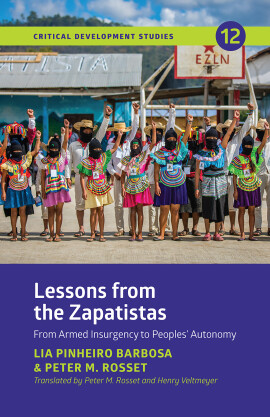
Development and Disasters
Natural hazards and vulnerability reduction
Good development could − and should − be the driving force for averting disasters by reducing vulnerability. But conversely, in many cases, development itself becomes a major cause of vulnerability and disasters.
This new edition describes the complex relationship between disasters and development, as a prime medium both of vulnerability and its reduction. Its chapters show that disasters are not events; they are processes. Disasters are not unusual; they are expressions of the everyday, everywhere normality. As such, ‘natural disasters’ do not exist, since they come from vulnerability, not from nature. Vulnerability accrues from processes of change, including development, disasters, and natural hazards. It is a potential product of all societal values, behaviours, activities, and undertakings.
To demonstrate that vulnerability through development is the root cause of disasters – that disasters are not ‘natural’ – this book starts with the patterns, meanings, manifestations, and experiences of vulnerabilities emerging from development. Vulnerability is made, leading to disaster risk creation. This vulnerability and development process is illustrated through historical examples from islands: sea-level rise affecting atolls, Tonga and Antigua across many hazards, and Sri Lanka and Chiswell in southern England affected by storms.
The rich theory and examples weaved throughout the book show how patterns of development can reduce and prevent vulnerability – and crucially how they can stop disasters.
Published: 2025
Pages: 202
eBook: 9781788533966
Paperback: 9781788533942
This new edition describes the complex relationship between disasters and development, as a prime medium both of vulnerability and its reduction. Its chapters show that disasters are not events; they are processes. Disasters are not unusual; they are expressions of the everyday, everywhere normality. As such, ‘natural disasters’ do not exist, since they come from vulnerability, not from nature. Vulnerability accrues from processes of change, including development, disasters, and natural hazards. It is a potential product of all societal values, behaviours, activities, and undertakings.
To demonstrate that vulnerability through development is the root cause of disasters – that disasters are not ‘natural’ – this book starts with the patterns, meanings, manifestations, and experiences of vulnerabilities emerging from development. Vulnerability is made, leading to disaster risk creation. This vulnerability and development process is illustrated through historical examples from islands: sea-level rise affecting atolls, Tonga and Antigua across many hazards, and Sri Lanka and Chiswell in southern England affected by storms.
The rich theory and examples weaved throughout the book show how patterns of development can reduce and prevent vulnerability – and crucially how they can stop disasters.
| About the authors | |||
|---|---|---|---|
| Foreword from the first edition | |||
| Preface from the first edition | |||
| Preface for the second edition | |||
| Acknowledgements | |||
| Chapter 1: Introduction: Vulnerability pasts | |||
| Part one: A pattern of vulnerability | |||
| Chapter 2: Meanings of vulnerability | |||
| Chapter 3: Present vulnerabilities | |||
| Chapter 4: Experiences of vulnerabilities | |||
| Chapter 5: Making vulnerability: Disaster risk creation | |||
| Part two: Vulnerability and development | |||
| Chapter 6: Detailed examples | |||
| Part three: A pattern for development | |||
| Chapter 7: Comprehensive development and disasters | |||
| Chapter 8: Preventive development for preventing disasters | |||
| Chapter 9: Vulnerability reduction in development | |||
| Chapter 10: Conclusion: Vulnerability futures | |||
| References | |||
| Index |
'The second edition of the book re-emphasizes the non-“natural” nature of disasters. With specific theory and practical examples, the book clearly identifies the importance of addressing different types of vulnerability, as well as the dynamic nature of the changes in the vulnerability. A must-read for researchers, practitioners and policy makers.'
Rajib Shaw, Professor, Graduate School of Media and Governance, Keio University, Japan
'From poverty to aging and depopulation, vulnerabilities in our societies are growing in scale and range. Focusing on preventative action before risks become disasters, and centring on reducing these vulnerabilities, Lewis and Kelman provide essential knowledge for policy makers and practitioners on how to achieve truly sustainable development.'
Mami Mizutori, former Special Representative of the UN Secretary General for Disaster Risk Reduction
'This book deepens the understanding that disasters stem from human-made vulnerabilities rather than natural events. Through thoughtful writing and rich historical examples, the authors vividly illustrate how development processes often create and perpetuate these vulnerabilities. The book underscores the crucial need to integrate vulnerability reduction into development practices to mitigate the impact of future disasters. Essential reading for policymakers, practitioners, and scholars alike.'
Bruce D Malamud, Director, Institute of Hazard, Risk and Resilience, Durham University
'In this significantly revised edition of his main opus published 25 years ago, James Lewis, accompanied by Ilan Kelman, crafts a comprehensive picture of the links between what we call development and disasters. More importantly, the authors identify key pathways to address some of the underlying issues that underpin people’s vulnerability in facing natural hazards. A must read for scholars, policy makers and practitioners.'
Professor JC Gaillard, The University of Auckland
James Lewis
James Lewis is a visiting fellow in Development Studies at the University of Bath and a consultant in environmental hazards and human settlements.
Ilan Kelman
Ilan Kelman is Professor of Disasters and Health at University College London, England and a Professor II at the University of Agder, Kristiansand, Norway.
Integrated risk governance in the Yungui Plateau, China: The 2008 ice-snow storm disaster
Ye, Qian
Wang, Ming
Han, Jiarui
(2012)
https://doi.org/10.4000/rga.1731 [Citations: 4]Entendre les préoccupations des populations des petits États insulaires en développement dans l’adaptation au changement climatique.
Masson, Virginie Le
Kelman, Ilan
VertigO, Vol. 10-3 (2011), Iss.
https://doi.org/10.4000/vertigo.10572 [Citations: 3]Gouvernance intégrée du risque sur le Plateau de Yungui, Chine : la catastrophe associée aux tempêtes de neige et aux pluies givrantes de 2008
Ye, Qian
Wang, Ming
Han, Jiarui
(2012)
https://doi.org/10.4000/rga.1723 [Citations: 0]





